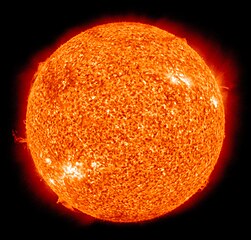Sun

|
| False-color photo of the Sun as seen in ultraviolet light (wavelength of 30.4 nm) |
The Sun, or Sol, is the star at the center of the Solar System.
The Sun is a G-type main-sequence star that comprises about 99.86% of the mass of the Solar System. The solar constant is the amount of power that the Sun deposits per unit area that is directly exposed to sunlight. The Sun is composed primarily of the chemical elements hydrogen and helium. The structure of the Sun contains the following layers: Core, radiative zone, tachocline, convective zone, photosphere, atmosphere. The Sun has a magnetic field that varies across the surface of the Sun. The Sun today is roughly halfway through the most stable part of its life. The Sun lies close to the inner rim of the Milky Way's Orion Arm, in the Local Interstellar Cloud or the Gould Belt, at a distance of 7.5–8.5 kpc (25,000–28,000 light-years) from the Galactic Center. The temperature of the photosphere is approximately 6,000 K, whereas the temperature of the corona reaches 1,000,000–2,000,000 K. The enormous effect of the Sun on Earth has been recognized since prehistoric times, and the Sun has been regarded by some cultures as a deity. The brightness of the Sun can cause pain from looking at it with the naked eye; however, doing so for brief periods is not hazardous for normal non-dilated eyes. The Sun has eight known planets. Solar deities play a major role in many world religions and mythologies.
